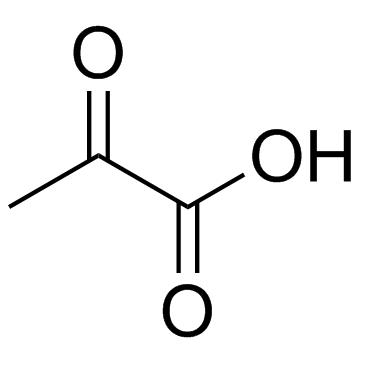Pyruvic acid

Pyruvic acid structure
|
Common Name | Pyruvic acid | ||
|---|---|---|---|---|
| CAS Number | 127-17-3 | Molecular Weight | 88.062 | |
| Density | 1.3±0.1 g/cm3 | Boiling Point | 165.0±0.0 °C at 760 mmHg | |
| Molecular Formula | C3H4O3 | Melting Point | 11-12 °C(lit.) | |
| MSDS | Chinese USA | Flash Point | 54.3±15.2 °C | |
| Symbol |

GHS05 |
Signal Word | Danger | |
|
Analysis of by-product formation and sugar monomerization in sugarcane bagasse pretreated at pilot plant scale: differences between autohydrolysis, alkaline and acid pretreatment.
Bioresour. Technol. 181 , 114-23, (2015) Sugarcane bagasse is an interesting feedstock for the biobased economy since a large fraction is polymerized sugars. Autohydrolysis, alkaline and acid pretreatment conditions combined with enzyme hydrolysis were used on lignocellulose rich bagasse to acquire ... |
|
|
Shigella reroutes host cell central metabolism to obtain high-flux nutrient supply for vigorous intracellular growth.
Proc. Natl. Acad. Sci. U. S. A. 111(27) , 9929-34, (2014) Shigella flexneri proliferate in infected human epithelial cells at exceptionally high rates. This vigorous growth has important consequences for rapid progression to life-threatening bloody diarrhea, but the underlying metabolic mechanisms remain poorly unde... |
|
|
Physiology and pathophysiology of organic acids in cerebrospinal fluid.
J. Inherit. Metab. Dis. 16(4) , 648-69, (1993) Concentrations of organic acids in cerebrospinal fluid (CSF) appear to be directly dependent upon their rate of production in the brain. There is evidence that the net release of short-chain monocarboxylic acids from the brain is a major route for removing th... |
|
|
The human serum metabolome.
PLoS ONE 6(2) , e16957, (2011) Continuing improvements in analytical technology along with an increased interest in performing comprehensive, quantitative metabolic profiling, is leading to increased interest pressures within the metabolomics community to develop centralized metabolite ref... |
|
|
Age-related reference values for urinary organic acids in a healthy Turkish pediatric population.
Clin. Chem. 40(6) , 862-6, (1994) Organic acid concentrations were quantified by gas chromatography and the individual acids identified by mass spectrometry in urine specimens from a healthy Turkish pediatric population of ages 2 days to 16 years, subdivided into five age groups. We quantifie... |
|
|
Automated screening of urine samples for carbohydrates, organic and amino acids after treatment with urease.
J. Chromatogr. A. 562(1-2) , 125-38, (1991) Eighty-five clinical urine samples and nineteen urine samples previously found by other laboratories to suggest genetic metabolic defects were prepared for trimethylsilylation by treatment with urease, followed by azeotropic dehydration. The "Target Analyte S... |
|
|
Quantitative analysis for organic acids in biological samples: batch isolation followed by gas chromatographic-mass spectrometric analysis.
Clin. Chem. 35(4) , 587-95, (1989) This new method for qualitative and quantitative determination of organic acids, aldehydes, and ketones in biological samples is effective for use with urine, plasma, and amniotic fluid, and it requires no deproteinization. Isolation by batch-wise liquid part... |
|
|
Intracellular flux analysis applied to the effect of dissolved oxygen on hybridomas.
Appl. Microbiol. Biotechnol. 44(1-2) , 27-36, (1995) Quantitative estimates of intracellular fluxes and measurements of intracellular concentrations were used to evaluate the effect of dissolved oxygen (DO) concentration on CRL 1606 hybridoma cells in batch culture. The estimates of intracellular fluxes were ge... |
|
|
The human cerebrospinal fluid metabolome
J. Chromatogr. B. Analyt. Technol. Biomed. Life Sci. 871(2) , 164-73, (2008) With continuing improvements in analytical technology and an increased interest in comprehensive metabolic profiling of biofluids and tissues, there is a growing need to develop comprehensive reference resources for certain clinically important biofluids, suc... |
|
|
Structural variation governs substrate specificity for organic anion transporter (OAT) homologs. Potential remote sensing by OAT family members.
J. Biol. Chem. 282 , 23841-53, (2007) Organic anion transporters (OATs, SLC22) interact with a remarkably diverse array of endogenous and exogenous organic anions. However, little is known about the structural features that determine their substrate selectivity. We examined the substrate binding ... |